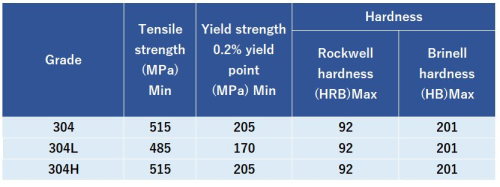304 is a type of standard “18/8” austenitic stainless steel. It is the most widely used and applied stainless steel with the most complete product forms, specifications and surface types. It has outstanding property of forming and welding.
304L is from grade 304 with a lower content of carbon, which does not require annealing after welding, and it is widely applied to make thick parts (about 5mm and above). The high carbon 304H could be used under high temperature. And the austenitic structure makes these grades have outstanding tenacity, even in freezing cold environments they stay in good tenacity.
304 stainless steel is capable of strict deep drawing processing without inter-process annealing. Therefore, it is predominantly the ideal material to produce stamping and drawing stainless steel parts (i.e. water channels, hollow vessels, and stew pots). In the strict application, it is suggested to choose the deep drawing series of 304DDQ.
Corrosion Resistance Performance
The series have good performance in various environments of atmosphere or corrosive mediums. It could have pitting and crevice corrosion in chloride of certain temperature, and stress-corrosion cracking above 60℃. At room temperature it stands in high chloride content of 200mg/L without pitting, and at 60℃ when the chloride content reduced to about 150mg/L, the corrosion resistance of 304 and 304L are not different.
Heat Resistance
When it is applied to intermittent use below 870°C, and continuous use below 925°C, there remains good antioxidation. If the follow-up corrosion in aqueous solutions is important, it is not suggested to use 304 stainless steel continuously at 425-860°C. 304L stainless steel is resistant to carbide precipitation, which could be applied to this range of temperature.
304H has a greater strength under high temperature, therefore it is usually applied in the structural and pressure-bearing use above 500℃ or even 800℃. 304H is likely to be sensitized at the temperature of 425-860°C. It does not cause any problems to high temperature use, but it would reduce corrosion resistance to aqueous solution.
Heat Treatment
Solution treatment (annealing)
Rapid cooling after heating to 1010-1120°C. These grades of stainless cannot be harden by heat treatment.
Welding Performance
The series are featured with outstanding welding performance, and they are applied to all standard fusion methods (with or without filler metal). Apply 308 welding rod to 304 in standard welding, and 308L (or the same grade with higher content of silicon) to 304L. If it is not possible to apply heat treatment to thick section after welding, 321 stainless steel is also a good substitution for 304.
Machining Performance
304 Ugima bar (machinability improved grade), has obviously superior machining performance than the standard grade of 304, and it assists faster processing speed and less cutting tool wear out.
Double-Grade Certification
304 and 304L generally has the Double-grade certification, especially sheet, tubing, and round bar. All the chemical contents and mechanical properties meet the standard specification of 304 and 304L. But the double-grade certified product may not be accepted in high temperature application.
Typical Application
Food processing, transportation and storage, especially equipment of beer brewery, winery and dairy processing, kitchen operating table, sink, equipment and appliance, architectural wallboard, handrail, and decorative parts, chemical transportation container, heat exchanger, weaved or welded sunshade screen, threaded fastener and spring etc.
Property Data of Standardized Specification
ASTM A240 / A240M have set the property of flat rolling product (medium thick, and general sheet, coil). There also sets capabilities of tubing and bar accordingly, which is similar, yet necessarily the same.
Property Standard

Mechanical Property

Physical Property (Annealing State)

Comparison of Standard Among Same Grade

Possible Substitution Grades
- 301/L – applicable to rolling and drawing parts of high hardening rate
- 303 – high machining property, low corrosion resistance, fine forming and welding application
- 316 – requires high pitting and crevice corrosion resistance in chloride environment
- 253MA – requires good thermostability, best above 1150°C
- 430 – cost reduction, and reasonable fine corrosion resistance and machining property
Source: 中国特钢企业协会不锈钢分会


